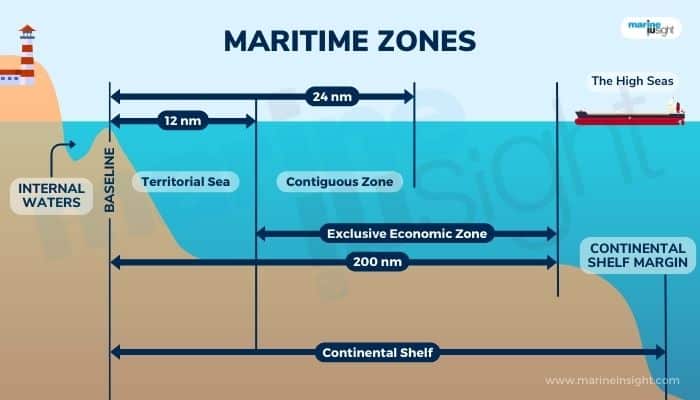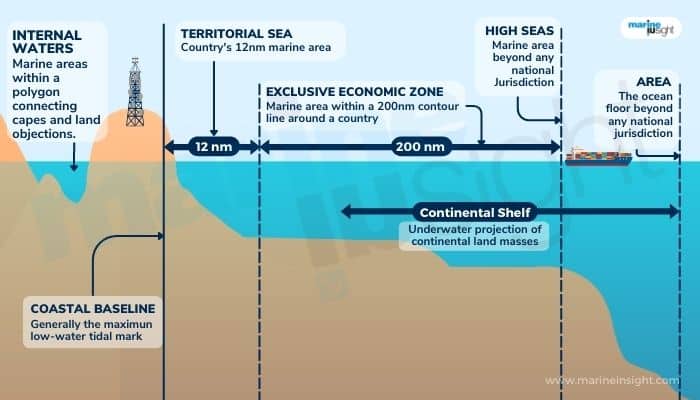Understanding International Waters: Boundaries, Jurisdiction And Legal Implications
The seas and oceans are divided into distinct maritime zones, each with its own legal framework and implications. International waters, also known as the high seas, play a crucial role in international law, navigation, and resource extraction.
Determining the boundaries and legal framework surrounding international waters is essential to ensure orderly conduct and promote global cooperation.
This article is divided into two parts.
The first one aims to provide a comprehensive overview of the different maritime zones, including the exclusive economic zone (EEZ), inland waters, contiguous zones, territorial sea, continental shelf, continental slope, and international waters; the second part deals with the high seas, in particular, focusing on their definition, boundaries, permissible activities, jurisdictional challenges, and legal implications and disputes.

Territorial Sea
The territorial sea is the area adjacent to a coastal state’s land territory. It extends up to 12 nautical miles (22.2 kilometres) from the baselines, which are the low-water lines along the coast. Within this zone, coastal states exercise full sovereignty, including the right to regulate and enforce laws on customs, immigration, and pollution control. The United Nations Convention on the Law of the Sea (UNCLOS) provides the legal framework for territorial seas.
Inland Waters
Inland waters refer to the bodies of water landward of the baseline, such as bays, rivers, lakes, and canals that are wholly or partially under the jurisdiction of a coastal state. Coastal states have complete sovereignty over these waters, including the right to establish and enforce laws and regulations. The extent of inland waters is determined by national legislation and international agreement.
Contiguous Zone
The contiguous zone is an area adjacent to the territorial sea, extending up to 24 nautical miles (44.4 kilometres) from the baselines. In this zone, coastal states have limited control to prevent and punish violations of their customs, fiscal, immigration, and sanitary regulations. However, the jurisdiction of coastal states in the contiguous zone does not extend to matters of navigation or overflight. UNCLOS provides the legal basis for the contiguous zone.
Continental Shelf
The continental shelf refers to the seabed and subsoil of the submarine areas that extend beyond the territorial sea, up to 200 nautical miles or beyond, where the natural prolongation of a coastal state’s land territory exists. Coastal states have sovereign rights over the exploration and exploitation of natural resources, both living and non-living, within their continental shelf. The outer limits of the continental shelf are determined through scientific and technical assessments.
Continental Slope
The continental slope is the seabed area beyond the continental shelf, where the depth rapidly increases towards the deep ocean floor. Although the continental slope is not defined as a separate maritime zone, it holds geological and ecological significance. Coastal states may have specific rights and responsibilities related to scientific research, environmental protection, and resource exploration in this area.
Exclusive Economic Zone (EEZ)
The EEZ is a zone adjacent to a coastal state’s territorial sea, extending up to 200 nautical miles (370.4 kilometres) from the baselines. Within the EEZ, coastal states have sovereign rights and jurisdiction over natural resources, both living (such as fish and other marine life) and non-living (such as oil, gas, and minerals). Coastal states also have the responsibility to conserve and manage these resources. UNCLOS provides the legal framework for the EEZ.
High Seas
The high seas, also known as international waters, are the areas of the world’s oceans that are beyond the jurisdiction of any particular state. These waters are open to all states and are governed by the principle of “freedom of the high seas.” States and individuals enjoy freedoms such as navigation, fishing, overflight, and laying of submarine cables. UNCLOS provides the legal framework for the high seas, including regulations on piracy, pollution, and conservation of marine resources.
Regulations and other aspects concerning High Seas
Where do international waters start?
International waters, also referred to as the high seas, are areas of the world’s oceans that are beyond the jurisdiction of any particular country. They exist beyond the territorial waters and contiguous zones of coastal states. The starting point of international waters is generally recognised as the point where a nation’s territorial sea ends, usually 12 nautical miles from the baseline of a coastal state. This principle is enshrined in the United Nations Convention on the Law of the Sea (UNCLOS) under Article 3.

How far offshore are international waters?
The commonly accepted distance for international waters is 12 nautical miles (approximately 22.2 kilometres) from the coastal baseline of a nation. This distance is based on the customary international law principle of the territorial sea, which grants coastal states certain rights and jurisdiction over a defined area extending from their coastlines. The exact measurement may vary depending on national legislation and bilateral agreements.
International waters distance
As mentioned earlier, international waters begin beyond the 12 nautical mile limit from the coastal baseline of a nation. These waters continue until the exclusive economic zone (EEZ) boundary, which typically extends up to 200 nautical miles from the coastal baseline, or until the outer limit of the continental shelf, whichever is further. The specific boundaries and limitations of the EEZ and continental shelf are determined based on UNCLOS provisions and relevant bilateral or multilateral agreements.
Can you do anything in international waters?
International waters are subject to the concept of “freedom of the high seas,” which grants states and individuals certain freedoms and rights. The article 87 (1) of the 1982 Convention, the freedoms of high seas expressly enumerate the following freedom:
- a) freedom of navigation;
- b) freedom of overflight;
- c) freedom to lay submarine cables and pipelines;
- d) freedom to construct artificial islands and other installations permitted under international law;
- e) freedom of fishing;
- f) freedom of scientific research.
It should be noted that a ship may not change its flag during a voyage or while in a port of call. (Article 92 (1)). Every State shall effectively exercise its jurisdiction and control in administrative, technical and social matters over ships flying its flag mentioned under Article 94 (1) of UNCLOS.
What happens if you commit a crime in international waters?
Crimes committed in international waters pose unique jurisdictional challenges. Generally, crimes committed aboard vessels in international waters fall under the jurisdiction of the flag state, which is the nation under whose laws the vessel is registered. This principle is codified in various acts and statutes, such as the Flag State Jurisdiction Act and the Law of the Sea Act. However, many countries exercise universal jurisdiction for certain serious crimes, such as piracy, drug trafficking, and terrorism, allowing them to prosecute individuals regardless of their nationality or the vessel’s flag.
What is illegal in international waters?
Certain activities are universally considered illegal in international waters. These include piracy, drug trafficking, human trafficking, illegal fishing, unauthorised dumping of hazardous materials, and engaging in acts of violence or terrorism. International treaties and conventions, such as UNCLOS, the International Convention for the Suppression of the Financing of Terrorism, and the United Nations Convention against Transnational Organized Crime, provide a legal framework to address such offences. Additionally, national laws of coastal states and international agreements may establish further regulations regarding specific activities in international waters.
Concept of Right to Hot Pursuit
An exception to the exclusive jurisdiction of the flag state over a vessel on the high seas is the right of hot pursuit. The right of hot pursuit is a principle to ensure a vessel which infringes the rules of a coastal state cannot escape punishment by fleeing to the high seas. In certain defined circumstances, a coastal state may extend its jurisdiction onto the high seas in order to pursue and seize a ship which is suspected of infringing its laws mentioned under Article 111 of the 1982 Convention.
Hot pursuit of a foreign vessel may be undertaken if there is good reason to believe that the vessel has violated the laws and regulations of the coastal State. Hot Pursuit must be commenced when the vessel or one of its boats is within the internal waters, archipelagic waters, the territorial sea or the contiguous zone. It may only be continued outside the territorial sea or contiguous zone if the pursuit has not been interrupted.
International waters vs High seas – What is the difference?
The terms “international waters” and “high seas” are often used interchangeably, as they both refer to the areas of the world’s oceans beyond the jurisdiction of any particular state. However, the technical distinction lies in their legal definitions. “High seas” specifically refers to the waters beyond national jurisdiction, while “international waters” is a broader term encompassing the entire spectrum of maritime spaces where international law applies.
The high seas mean all the parts which are not coming under EEZ, territory or inland waters of a country. “Mare Liberum”, meaning the sea could not be owned by anyone. Article 87(2) of UNCLOS lays down the limitation of the general nature on the freedom of high seas by stating that the freedom of the high seas “shall be exercised with due regard to the interests of other States in their exercise of the freedom of high seas”.
Can you drill for oil in international waters?
The exploration and exploitation of natural resources, such as oil and gas, in international waters are subject to specific rules and regulations. UNCLOS provides a legal framework for the exploitation of non-living resources in the Area, which refers to the seabed and subsoil beyond the limits of national jurisdiction.
It establishes the International Seabed Authority (ISA) to regulate and manage activities related to deep seabed mining. However, drilling for oil and gas in international waters outside the Area is generally subject to agreements between states, customary international law, and commercial arrangements, including the granting of licenses and adherence to environmental protection standards.
International Tribunal for the Law of the Sea (ITLOS)
After the entry into force of the UNCLOS in 1994, strong efforts were made for the establishment of an International Tribunal for the Law of the Sea (ITLOS). The ITLOS is an intergovernmental organisation created by the mandate of the Third UN Conference on the Law of the Sea. It was established by the UN Convention on the Law of the Sea, signed at Montego Bay, Jamaica, on 10th December 1982. The ITLOS was ultimately established on 21st October 1996, of which jurisdiction is not compulsory and is optional or based on the consent of the States.
Some Famous Maritime Disputes
1. Chile-Peru High Seas Squid Dispute:
Chile and Peru have had a long-running dispute over the management and exploitation of the Humboldt Current’s squid resources on the high seas. The conflict mainly revolves around differing interpretations of the maritime boundary and the impact of each country’s fishing practices on the shared squid stock.
2. Spain-Canada Turbot War:
In the 1990s, Spain and Canada became embroiled in a high seas dispute known as the “Turbot War.” The conflict arose when Spanish trawlers were accused of overfishing turbot in international waters off the coast of Newfoundland, Canada. Canada responded by seizing Spanish fishing vessels, leading to heightened tensions and a diplomatic standoff between the two countries.
3. Japan-Russia Northern Territories Dispute:
Japan and Russia have a territorial dispute over the Kuril Islands, located in the northern Pacific Ocean. The disagreement includes the issue of fishing rights and access to the rich marine resources surrounding the islands. The dispute has affected bilateral relations and hindered cooperation in the region.
4. Taiwan-Japan Fishing Rights Dispute:
Taiwan and Japan have periodically clashed over fishing rights in the waters surrounding the disputed Senkaku/Diaoyu Islands in the East China Sea. Both countries claim sovereignty over the islands and have differing interpretations of fishing rights and maritime boundaries in the area. The dispute has led to fishing vessel clashes and increased tensions between the two nations.
5. Iceland-Britain Cod Wars:
Iceland and the United Kingdom were involved in a series of conflicts known as the “Cod Wars” during the mid-20th century. The disputes centred around Iceland’s extension of its fishing limits in the North Atlantic, affecting British fishermen’s access to cod-rich waters. The conflicts involved the deployment of naval vessels and resulted in changes to international law regarding exclusive economic zones.
Conclusion
Understanding the legal aspects of international waters is crucial for promoting maritime cooperation, ensuring navigational safety, and addressing criminal activities in these areas.
The boundaries, permissible activities, jurisdictional challenges, and legal implications associated with international waters are governed by international conventions, national legislation, and bilateral/multilateral agreements. Compliance with these legal frameworks is essential for maintaining peace, security, and sustainable use of marine resources on the high seas.
You might also like to read-
- 6 Reasons That Lead To Port Congestion
- Understanding Maritime Towage And Salvage
- What Do You Mean By Humanitarian Logistics?
- 10 Trends Expected To Define Supply Chains And Shipping In 2023
- Differences And Correlation Between Spot Rates And Contract Rates in Shipping
- 6 Reasons That Lead To Port Congestion
Disclaimer: The authors’ views expressed in this article do not necessarily reflect the views of Marine Insight. Data and charts, if used in the article, have been sourced from available information and have not been authenticated by any statutory authority. The author and Marine Insight do not claim it to be accurate nor accept any responsibility for the same. The views constitute only the opinions and do not constitute any guidelines or recommendations on any course of action to be followed by the reader.
The article or images cannot be reproduced, copied, shared or used in any form without the permission of the author and Marine Insight.
Do you have info to share with us ? Suggest a correction

About Author
Rishabh Srivastava is a Maritime lawyer dealing in Ship arrests, maritime claims and arbitration in India.
Latest Maritime law Articles You Would Like:
Latest News
- What is the Purpose of DG Shipping?
- What are Logistics Risks?
- How Port and Terminal Operators Can Control Emissions?
- Minimum Quantity Commitment (MQC) and Liquidated Damages in Container Shipping: Concept and Relevance
- MARPOL (The International Convention for Prevention of Marine Pollution For Ships): The Ultimate Guide
- The Ultimate Shipping Container Dimensions Guide
Subscribe To Our Newsletters
By subscribing, you agree to our Privacy Policy and may receive occasional deal communications; you can unsubscribe anytime.















